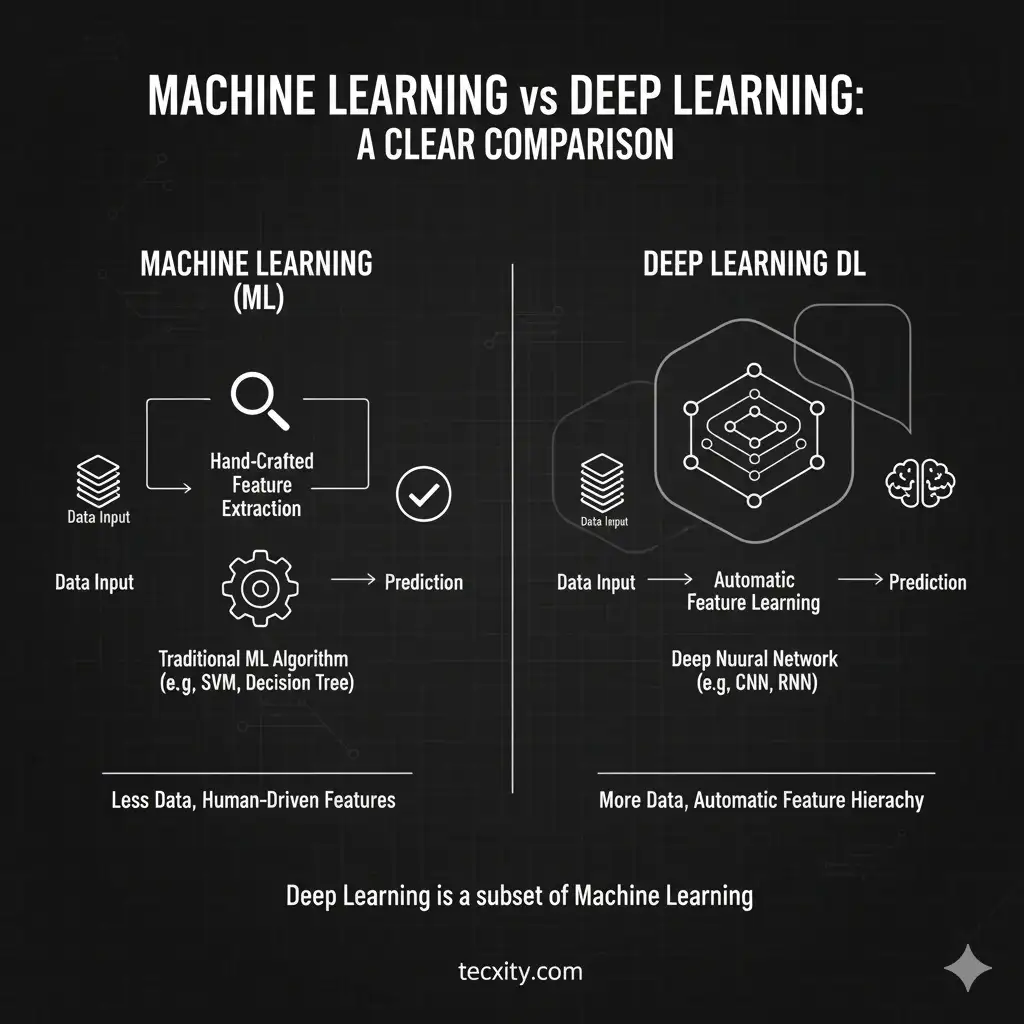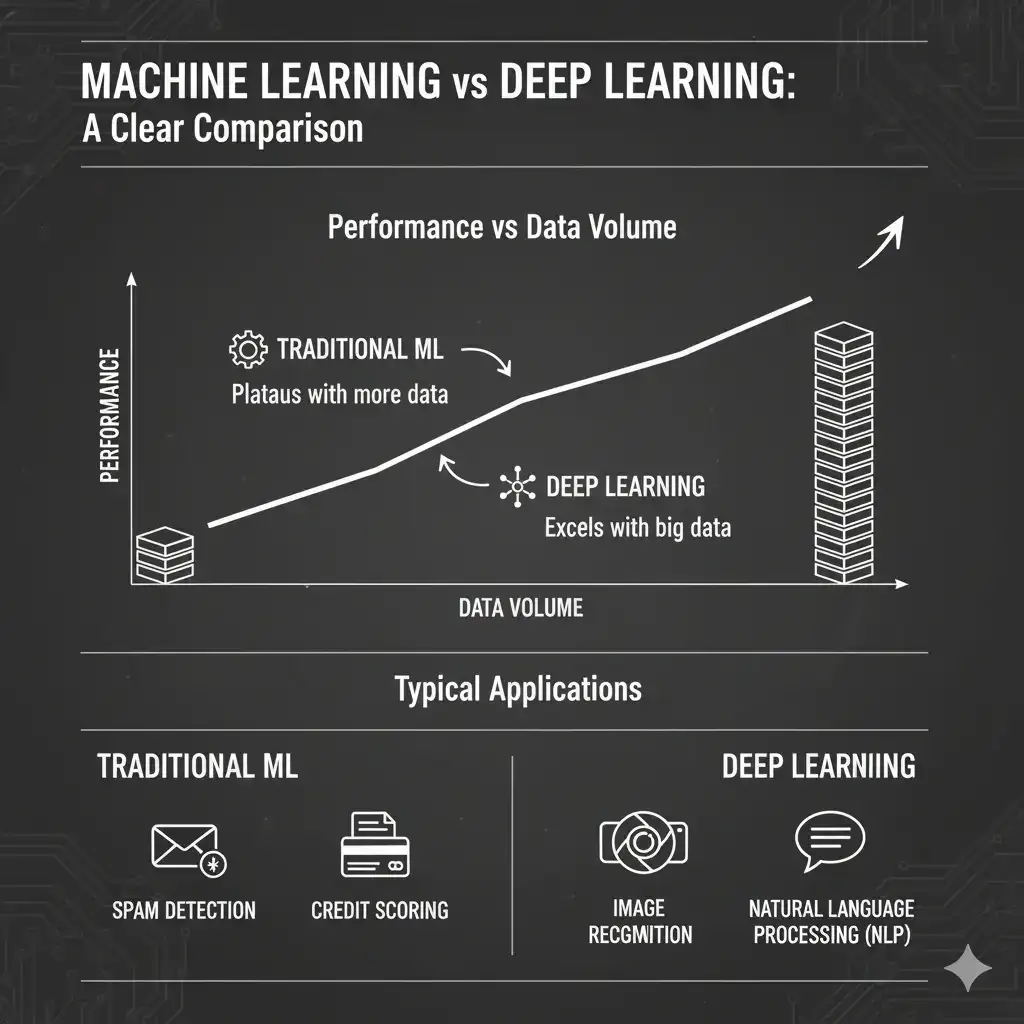
When I first dipped my toes into AI, I was instantly confused. Everyone kept throwing around terms like Machine Learning and Deep Learning as if they were the same thing. Trust me, I’ve been there staring at diagrams, Googling endless explanations, and still wondering what really sets them apart.
Over time, I realized that ML and DL aren’t competitors, they’re partners. One lays the foundation, and the other tackles complex problems. Today, I want to walk you through everything I’ve learned, from basics to real-world applications, in a way that’s simple, human, and actionable.
By the end of this article, you’ll know how ML and DL differ, when to use each, and how they’re shaping our world today.
What Is Machine Learning?
Let’s start with an example. Imagine you’re teaching a child to recognize fruits. You show pictures of apples and oranges and explain the differences in color, shape, texture. Eventually, the child learns to identify fruits on their own.
That’s Machine Learning in a nutshell. Computers learn patterns from data without being explicitly programmed.
Key Points About ML:
- Algorithms: Linear regression, decision trees, random forests, SVMs.
- Data: Works well with small to medium datasets.
- Interpretability: Easy to understand why a prediction was made.
- Applications: Spam detection, recommendation engines, fraud detection.
From my experience, ML is approachable and gives you results quickly, making it perfect for beginners.
What Is Deep Learning?
Now imagine instead of showing a child a few examples, you expect them to learn all patterns from thousands of images, picking out subtle differences like lighting, angle, and background.
That’s Deep Learning a subset of ML using artificial neural networks to mimic the way the human brain learns.
Key Points About DL:
- Architecture: Multi-layered neural networks.
- Data Requirement: Needs large datasets.
- Computation: Requires GPUs or specialized hardware.
- Applications: Image recognition, NLP, autonomous vehicles.
DL is powerful but resource-intensive. It’s best for complex, unstructured data problems.
Key Differences: Machine Learning vs Deep Learning
Here’s a side-by-side comparison table to make things crystal clear:
| Feature | Machine Learning (ML) | Deep Learning (DL) |
| Definition | Algorithms that learn patterns from data | Neural networks that learn patterns from large datasets |
| Data Requirement | Small to medium datasets | Large datasets |
| Hardware | Can run on standard CPUs | Requires GPUs/TPUs |
| Feature Engineering | Manual selection needed | Learns features automatically |
| Interpretability | High | Low (“black box”) |
| Training Time | Short | Long |
| Applications | Fraud detection, spam filters, recommendations | Image classification, speech recognition, autonomous driving |
Consider adding a diagram of ML vs DL hierarchy here it helps readers visualize the relationship.

Real-World Applications
Machine Learning Applications
- Recommendation Systems – Netflix predicts what I might want to watch next.
- Fraud Detection – Banks flag unusual transactions in real time using ML models.
- Email Filtering – Gmail’s spam detection is powered by ML.
Deep Learning Applications
- Image Recognition – Facebook tags people in photos automatically.
- Speech Recognition – Siri, Alexa, and Google Assistant rely heavily on DL.
- Autonomous Vehicles – Self-driving cars use deep neural networks to interpret the environment.
From my perspective, ML is perfect for structured, simpler data, while DL excels with unstructured data like images, audio, and video.
When to Use Machine Learning vs Deep Learning
Here’s a practical guide based on my experience:
Use ML when:
- You have smaller datasets.
- You need explainable predictions.
- Resources are limited (no heavy GPUs).
Use DL when:
- You have large datasets.
- The problem is complex and non-linear.
- You need to process images, audio, or video.
For example, if I’m building a sales prediction model, ML is sufficient. But if I want a system to detect cancer in X-ray images, DL is the obvious choice.
Pros and Cons
Machine Learning
Pros:
- Easier to implement and interpret
- Works with small datasets
- Faster training
Cons:
- Needs feature engineering
- Limited in handling unstructured data
- May underperform on complex patterns
Deep Learning
Pros:
- Excels with large, unstructured data
- Learns features automatically
- Powerful for complex tasks
Cons:
- Requires huge datasets
- Computationally expensive
- Less interpretable
Actionable Takeaways for Learners
Here’s what I recommend based on my own journey:
- Start with Python – It’s beginner-friendly and has great ML/DL libraries.
- Learn Machine Learning First – Build a foundation with scikit-learn.
- Practice on Real Datasets – Kaggle is a goldmine.
- Move to Deep Learning Gradually – Use TensorFlow or PyTorch.
- Work on Projects – For example, sentiment analysis, image classification, or fraud detection.
Document your projects. It will help you showcase your skills to employers or clients.
FAQs: Machine Learning vs Deep Learning
Q1: Is deep learning better than machine learning?
Not necessarily. It depends on dataset size, problem complexity, and resources. ML can outperform DL on small datasets.
Q2: Which should I learn first?
Start with Machine Learning, then progress to Deep Learning.
Q3: Do I need GPUs for Deep Learning?
Yes, especially for large neural networks. GPUs accelerate training dramatically.
Q4: Can beginners use ML and DL?
Absolutely! Start with libraries like scikit-learn (ML) and TensorFlow/Keras (DL).
Q5: Can businesses benefit from ML and DL?
Yes. ML improves decision-making and automation. DL enables advanced AI applications like voice assistants and image analysis.
Conclusion
In my journey learning AI, I realized ML and DL are not competitors—they’re complementary. ML gives us the foundation to understand data patterns, while DL tackles complex problems we couldn’t solve before.
If you’re just starting out, learn ML first, then gradually explore DL. That’s the path I took, and it helped me see the big picture clearly.
Whether you’re a beginner, student, or business professional, understanding the differences, applications, and strengths of ML and DL will empower you to make smarter AI decisions.
Next time someone asks you the difference between Machine Learning and Deep Learning, you’ll not only answer they’ll understand, because you can explain it in human terms.
